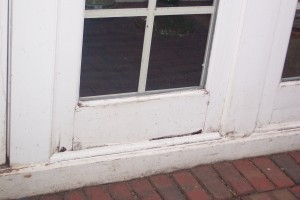“Green” paint products and practices are becoming an integral part of the arsenal of true painting craftsmen. For instance, epoxy wood restoration is one of those areas.
In the Northern United States, houses are subjected to an array of punishing climatic shocks that can result in the rapid deterioration of wood surfaces, unless someone keeps a close eye on the maintenance of those surfaces. Window sills, bottom rails of doors and casings are especially vulnerable to the effects of the sun, moisture and snow. Still today, a common attitude is this: If there is wood rot, rip out the old wood!
There are two significant problems with this attutude. First of all, it kills trees and loads up the landfills. Moreover, especially for older houses, the wood being so willingly replaced is actually far superior in quality and durability than today’s woods, which are younger, softer and more porous than the old woods. If you are interested in preserving the integrity of the materials on your house, epoxy wood restoration makes a lot of sense!
Epoxy wood restoration is not a new concept. However, it use is becoming more widespread. At Painting in Partnership from the Chicago area, we encounter plenty of rotting wood. Our product of choice is Flex-Tec.
I often compare epoxy repair to dentistry. First you clear out the decayed fibers. You then make sure that the remaining cavity is of a shape that can hold the epoxy filler. On occasion, the decay is so extensive that the tooth has to be replaced. In other occasions, epoxy is the perfect solution. Before proceeding with the epoxy work, make sure that the moisture in the wood does not exceed 18%. If it does, let the wood dry out. When the wood is dry, you first use a two-part consolidator to help harden the softer wood edges and create a good bond for the epoxy. You then add the two-part epoxy filler. You then shape the epoxy as desired and allow it to cure completely.









 Follow
Follow
